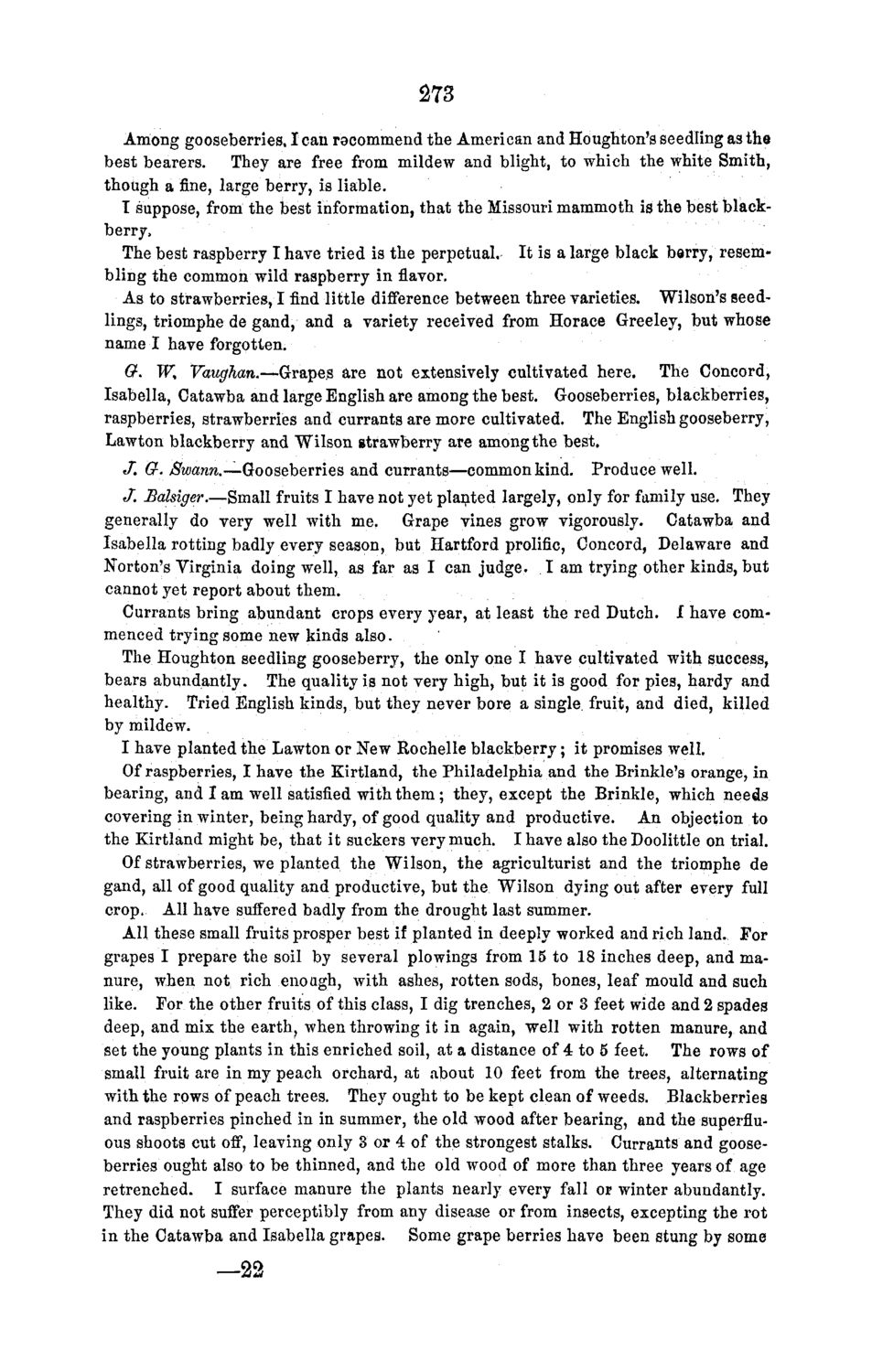| |
| |
Caption: Board of Trustees Minutes - 1868
This is a reduced-resolution page image for fast online browsing.

EXTRACTED TEXT FROM PAGE:
273 Among gooseberries, lean racommend the American and Houghton's seedling as the best bearers. They are free from mildew and blight, to which the white Smith, though a fine, large berry, is liable. T suppose, from the best information, that the Missouri mammoth is the best blackberry, The best raspberry I have tried is the perpetual. It is a large black borry, resembling the common wild raspberry in flavor. As to strawberries, I find little difference between three varieties. Wilson's seedlings, triomphe de gand, and a variety received from Horace Greeley, but whose name I have forgotten. G. W% Vaughan.—Grapes are not extensively cultivated here. The Concord, Isabella, Catawba and large English are among the best. Gooseberries, blackberries, raspberries, strawberries and currants are more cultivated. The English gooseberry, Lawton blackberry and Wilson strawberry are among the best. J. G. JSwann.—Gooseberries and currants—common kind. Produce well. / . Balsiger.—Small fruits I have not yet planted largely, only for family use. They generally do very well with me, Grape vines grow vigorously. Catawba and Isabella rotting badly every season, but Hartford prolific, Concord, Delaware and Norton's Virginia doing well, as far as I can judge. I am trying other kinds, but cannot yet report about them. Currants bring abundant crops every year, at least the red Dutch. I have commenced trying some new kinds also. The Houghton seedling gooseberry, the only one I have cultivated with success, bears abundantly. The quality is not very high, but it is good for pies, hardy and healthy. Tried English kinds, but they never bore a single fruit, and died, killed by mildew. I have planted the Lawton or New Rochelle blackberry; it promises well. Of raspberries, I have the Kirtland, the Philadelphia and the Brinkle's orange, in bearing, and I am well satisfied with them ; they, except the Brinkle, which needs covering in winter, being hardy, of good quality and productive. An objection to the Kirtland might be, that it suckers very much. I have also the Doolittle on trial. Of strawberries, we planted the Wilson, the agriculturist and the triomphe de gand, all of good quality and productive, but the Wilson dying out after every full crop. All have suffered badly from the drought last summer. All these small fruits prosper best if planted in deeply worked and rich land. For grapes I prepare the soil by several plowings from 15 to 18 inches deep, and manure, when not rich enoagh, with ashes, rotten sods, bones, leaf mould and such like. For the other fruits of this class, I dig trenches, 2 or 3 feet wide and 2 spades deep, and mix the earth, when throwing it in again, well with rotten manure, and set the young plants in this enriched soil, at a distance of 4 to 5 feet. The rows of small fruit are in my peach orchard, at about 10 feet from the trees, alternating with the rows of peach trees. They ought to be kept clean of weeds. Blackberries and raspberries pinched in in summer, the old wood after bearing, and the superfluous shoots cut off, leaving only 3 or 4 of the strongest stalks. Currants and gooseberries ought also to be thinned, and the old wood of more than three years of age retrenched. I surface manure the plants nearly every fall or winter abundantly. They did not suffer perceptibly from any disease or from insects, excepting the rot in the Catawba and Isabella grapes. Some grape berries have been stung by some —22
| |